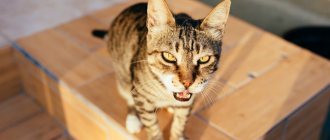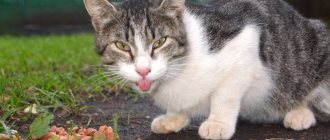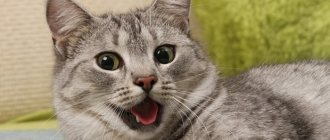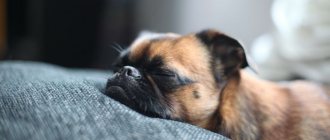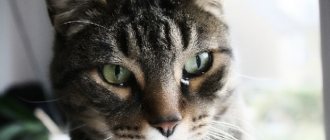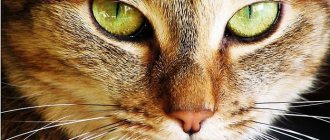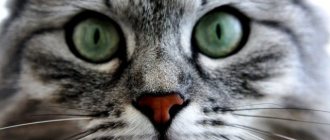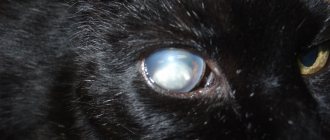The normal state of a cat's pupils
Cats are predators, their eyes have a thin vertical stripe.
Cats, like many predators, have vertical pupils. Cats need this shape of pupils in order to assess the distance to the object of hunting and during a jump, attack on the sly.
The retina of a cat’s eye is very sensitive to light, and this is the answer to why cats’ pupils narrow in the light and dilate as much as possible in the dark. In the dark, dilated pupils allow more light to pass through and thus see even at night. And so that the bright light from the sun does not harm the cat’s vision, when light or a ray of sun hits the animal’s eyes, the pupil narrows as much as possible to a vertical strip.
The normal state of a cat's pupils is constricted, which reacts by dilation and contraction to light or external stimuli.
When dilated pupils in a cat are a sign of normality
Cats' pupils dilate naturally when reacting to light, fear or interest.
Dilation and constriction of a cat's pupils, which occur temporarily at the time of reaction, are considered normal.
Most often, dilated pupils in an animal can be observed during estrus. The hormones produced by the cat during this time often cause her pupils to dilate. They symbolize the female's desire and desire to find a male to mate with. This is the natural state of the animal and there is absolutely nothing to be afraid of.
Also, the pupils can dilate in response to light: the darker it is, the larger the cat’s pupils.
Including as a reaction to an external stimulus: to a sharp sound, to sudden stress. A cat dilates its pupils when it gets scared. This means she is ready to attack.
The reason could be a new pet in the house, a stranger, moving to a new place unfamiliar to the cat.
A cat's pupils dilate during games, fights, and while bathing.
In such cases, there is no need to fear for the animal’s health, and dilated pupils under these circumstances are the norm and a natural reaction of the pet.
Complications
The animal's condition may worsen so much that it falls into a coma.
When a cat is breathing frequently, it is necessary to quickly take measures to alleviate this condition. Otherwise, due to lack of air, oxygen starvation of the brain and internal organs develops. The heart muscle suffers greatly, the load on which increases significantly. If the animal does not move and does not react to external stimuli, it may be in deep fainting or coma, the outcome of which can be unpredictable, even up to the death of the four-legged friend.
Pathological causes of dilated pupils
Dilated pupils in a cat are not always normal
Large dilated pupils in cats for a long time, without any particular reason, may be a signal that the animal has a disease.
What you need to pay attention to:
- Based on the age of the animal. As a cat ages, it may develop loss of retinal sensitivity;
- For head injuries. With a concussion, the cat could have damaged blood vessels, which caused the pupil to dilate. As a rule, this goes away within a couple of hours, if it does not go away, you should consult a doctor;
- Dilated pupils are accompanied by decreased activity, unusual postures for the animal, and impaired coordination of movements. This may be caused by a brain tumor. The cat needs to be examined at a veterinary clinic;
- Cloudy corneas, along with dilated pupils, can develop due to injury or internal infections.
Ophthalmological problems
This is what the eyes of an animal with retinal disease look like
Dilated pupils in a cat for a long time can result in eye diseases, such as:
- Cataracts usually affect older cats. The disease manifests itself as clouding of the cornea with a bluish tint.
- Retinal atrophy. The disease is inherited and mainly in purebred cats. May cause blindness.
- Blepharitis is inflammation of the eyelids.
- Conjunctivitis is expressed in the appearance of mucous and purulent discharge from the eyes. It can be either infectious or allergic, and can also develop due to a foreign object entering the animal’s eye.
Treatment of these diseases is prescribed by a veterinarian.
Conjunctivitis may go away on its own, but it is advisable to rinse your eyes with tea leaves or Miramistin.
Reaction to pain and possible diseases
Persistent dilated pupils and cats may be due to pain
When a cat is in pain, she almost never shows it. These animals are very patient. Dilated pupils may indicate that the animal is in pain. Carefully monitor the animal's behavior; it may have injured itself or sprained its paw. Then, in addition to dilated pupils, she will lick the injured area and move strangely.
But the pain can be internal and associated with various diseases:
- a brain tumor;
- heart disease, kidney disease, stomach disease;
- stroke;
- internal bleeding;
- poisoning or infections
In such cases, delay is dangerous, since the owner’s timely response is very important for the life and health of the pet.
State of stress
The cat may be chronically stressed or fearful
A cat's pupils may dilate during sudden stress or fright caused by a loud noise, a vacuum cleaner, a hair dryer, or as a reaction to a new pet or person. The animal's tail fluffs up, its ears press against its head, and it may hiss. But when the irritant disappears, the cat will calm down and return to its normal state.
But stress can also be permanent. It is expressed in increased blood pressure and rapid breathing. In this state, the animal’s immunity is weakened and digestion slows down. Stress can be a factor in the development of various diseases.
What can cause stress
Many factors can cause fear in an animal; it is advisable to avoid them
- late socialization. The cat may be afraid of both the owner and other people living with him;
- poor nutrition;
- violence by people or other animals;
- taking medications, injections during treatment - cats don’t like this;
- going to the vet;
- moving;
- water procedures.
During prolonged stress, cats' appetite worsens, they hide, react with aggression, and lose their playful mood. The general behavior of the cat changes, it becomes uncommunicative, isolates itself, licks its fur nervously, itches frequently, may urinate past the litter box, reacts to every sound with sudden movements, jumping, and fluffs its tail.
To calm the animal, you need to exclude its contact with the object of stress, feed it something tasty, pet the animal more, speak in a calm voice, and do not shout.
Natural causes
- Estrus and the call of nature. During the period when cats of both sexes need a sexual partner, and hormones are raging in the body, a lot changes - behavior, physiological indicators, and some metabolic processes. So, if you see dilated pupils on your pet during estrus, you shouldn’t be scared - this is normal. In addition, other signs appear: the animal begins to visit the litter box more often (urination increases), the cat breathes with its mouth open in an attempt to smell the female, intensive licking of the perineum begins, and so on. As a rule, this goes away with the end of estrus, and the cat's pupils become normal sizes.
- The cat is alarmed and nervous. A state of stress, depression or a constant feeling of anxiety also affects the size of the pupils. Many owners who have just got a shaggy pet have noticed that the cat's pupils, regardless of the lighting in the room, are constantly dilated. And this can be explained very simply - the cat has not yet settled into its new home, has not gotten used to it and has not studied the situation, so it expects an attack from an unknown enemy every minute. A similar reaction is observed when another relative begins to live in the neighborhood and you have to share territory and other things with him. In such cases, the pupils become very wide, plus this is accompanied by caution and constraint in movements, insinuating. Especially if the “alien” is nearby. After some time, the pet will get used to its new neighbor, and the pupils will become normal again.
- Games, hunting, movement. When a cat is resting (not necessarily sleeping), the pupils are usually narrow. And with the onset of evening, a normal cat begins to move, and a wild desire to play begins. And as soon as she starts jumping around the house, looking wildly at her surroundings, you can notice that her eyes turn into giant “saucers”. Thus, they respond to the release of adrenaline into the body. This is a completely natural and even necessary process for the animal: you can better see the outlines of objects encountered along the road, while deftly dodging them and without the risk of injury. Moreover, the chance of seeing prey increases, which, according to the cat’s estimates, will definitely appear from some secret corner (the owners know that there are no mice behind the closet, and the cat’s hope is so great!).
- The world around is full of dangers. The cat's pupil is unique and can instantly change shape if the cat suddenly sees danger. If, for example, the owner intends to dip an experienced feline person into a bath of water, then the eyes of the indignant, indignant cat will turn into two barely noticeable slits. The gaze will be focused on the potential victim, who definitely needs to take revenge. And the inexperienced, naive young cat will have one desire - to find out who the villain is who threw her into the water. And, gripped by fear and uncertainty, she will try to take in the entire room with her gaze, and the pupils will dilate, filling the entire eye space.
We suggest you read: Is it possible to wash a cat’s eyes with miramistin?
The eyes become huge due to frightening loud sounds from nowhere, incomprehensible rustles and other surprises that traumatize the cat’s peace.
The cat's eyes are watering: why and what to do?
Why don't my cat's pupils react to light?
The reason that a cat does not react to light, its pupils do not constrict, may be various types of diseases:
- Glaucoma is expressed as clouding of the cornea due to increased intracranial pressure. It can cause a reaction in one eye, and in later stages in both. The cat's pupils stop responding to light, strabismus develops, and ultimately the disease can lead to blindness.
- Retinal detachment interrupts the blood supply to the eyeball and the retina stops functioning normally. Lack of reaction to light. Dilated pupils and a floating transparent retina are obvious symptoms.
- Hypertensive retinopathy. In this process, the retina and blood vessels are affected due to kidney disease or hyperthyroidism. In this case, the cat has no reaction to light, dilated pupils and blood vessels in the eyeballs. The animal's condition is inactive, lethargic, coordination is impaired.
Diagnosis and treatment
Sometimes a cat's pupils appear different due to minor injuries or stress. In such situations, the problem disappears within 24 hours. Often the pet's condition is not cause for concern. He sleeps peacefully and eats well, there are no problems with the toilet. But if the symptoms do not disappear after a while, the disease should be suspected.
Only a doctor can make a diagnosis and find out the root cause why one pupil is narrow and the other wide, after conducting an examination. Veterinarians insist on carrying out the following procedures:
- examination by an ophthalmologist;
- taking blood and urine tests;
- x-ray (if injury is suspected);
- Ultrasound of the eyeball and measurement of intraocular pressure;
- tomography or MRI diagnostics;
- bone marrow biopsy.
The disease is quite difficult to treat, so the owner of the animal must be prepared for a long recovery. Rehabilitation of a pet directly depends on the causes of the disease. The doctor may prescribe treatment with antibiotics or anti-inflammatory drugs. The presence of tumors requires surgery. It is necessary to identify and treat the underlying disease and the size of the pupils in both eyes will no longer cause concern.
Anisocoria in an animal requires prompt consultation with a doctor.
If the cat’s pupils are dilated all the time or it becomes noticeable that one is enlarged and the other is narrowed, you should not wait for the condition to normalize on its own. It is necessary to take your pet to a veterinarian as soon as possible, who, after determining the causes of the pathology, will advise what to do next.
We invite you to read: Guests from distant Africa » MK "Diamond Region"
At the initial appointment, the doctor will examine the eyes and try to find out the root cause under the influence of which the pupils have enlarged. To confirm the diagnosis, the following diagnostic procedures are additionally prescribed:
- ophthalmoscopy;
- Ultrasound;
- ECG;
- radiography;
- measurement of intraocular pressure;
- biomicroscopy;
- fluorescein angiography;
- general clinical and biochemical blood test.
If different pupils are observed in a cat, the following is carried out:
- CT or MRI of the brain;
- electroretinography;
- cerebrospinal fluid analysis.
A cat has different pupils: should it be treated?
Different pupils in a cat are a sign of disease
Cats with different colored pupils are called heterochrony. The iris of the eye is not the same. It can stain the entire eye or part of it. This is not a disease and is not dangerous to the health of the animal.
However, if the differences in the eyes consist of dilated and constricted pupils at the same time, this indicates the presence of diseases in the animal.
A cat's pupil is located in the middle of the iris, through which light passes into the retina. When exposed to light, the pupils constrict at the same time, and in the dark, they also dilate at the same time.
When one pupil is constricted and the other is dilated, the cause is the disease anisocoria. It is necessary to check each pupil for reaction to light. One that does not react to light and is susceptible to pathology, it can be, as always, narrowed, and always expanded.
In this case, the animal needs to visit a veterinary clinic and be examined for various diseases, since there can be many reasons for anisocoria.
- Eye diseases: glaucoma, damage to the cornea, disease or atrophy of the retina, uveitis (inflammation of the inside of the eye, mainly the pupil in this disease is narrowed),
- head injury, concussion, brain tumor;
- inflammation, disorders of the optic nerves;
- eye cancer;
- a congenital defect of the iris in which the tissue does not develop properly
- seizure disorder, which may be associated with leukemia in cats;
- disruption, damage or inflammation of the ocular vessels
To make an accurate diagnosis and find out what exactly caused the cat’s different pupils, you must urgently consult a veterinarian. Some diseases are serious and can lead to blindness, organ loss or death.
Alarming symptoms
Eye diseases If the cat’s health and mood are fine, but the pupils are of different sizes or are dilated all the time, then we can say that the eyes are affected by a disease. As vision decreases, light sensitivity decreases and the pupils do not constrict. If both eyes are sick, both pupils will be round, but if they are different, only one eye is sick, and the other reacts the same way to changes in lighting.
Most often, different eyes occur with the following diseases:
- closed glaucoma;
- retinal atrophy;
- dislocation of the eye lens;
- the ocular blood supply is impaired;
- posterior uveitis.
These diseases are fraught with considerable danger and can make the animal blind. And it doesn’t matter that treatment was started in a timely manner. Therefore, it is better to immediately visit an ophthalmologist-veterinarian.
Endure pain Another bad reason for dilated cat pupils is constant, incessant pain. Cats are quite patient and never show how much pain they are in. They are patient with cramps, spasmodic manifestations, and never complain when injured, etc. Therefore, it is rare that an owner notices that his pet has been suffering from pain for several weeks in a row.
If the cat moves little, takes an unnatural position while sleeping, its gait is constrained - this may be the cause of aching constant pain (kidneys, stomach, heart hurt, a part of the body is affected by a tumor, an infection has begun, and so on).
If your pet constantly has wide pupils, you need to immediately run to the veterinarian! The specialist will do the necessary tests, assess the cat’s condition and prescribe the necessary course of treatment.
We suggest you read: Why does umbilical hernia appear and how is it treated in cats?
Poisoning When a cat, along with large pupils, experiences poor coordination of movements, nausea and vomiting, we can say with complete confidence that the animal has been poisoned. You should pay attention to how often vomiting occurs, the intensity of the eye's reaction to light, and take your animal to the veterinarian. Usually, dilated pupils indicate poisoning with substances that are difficult to remove from the cat’s body on their own. For example, a pet could be poisoned by medications, some plant containing poison, or food of poor quality (or poisoned).
Age, old age Very often, dilated pupils are observed in old and elderly cats. Vision deteriorates, becomes weaker, and the cornea becomes clouded. Old animals no longer constrict their pupils when it is light; their eyes react less to light. But with an excess of it, they still narrow a little.
You should not try to find out on your own the reasons why your beloved cat’s pupil sizes change. The natural causes described here are also possible, or maybe the animal is sick. While the owner wonders what happened, the disease will develop. It is better to contact a veterinarian who will examine your pet and prevent him from going blind.
A cat has a cloudy eye: why and what to do?
What should the owner be wary of?
A change in habitual behavior is not normal for an animal, it means something is bothering him
The owner usually always notices changes in the behavior of his pet. Serious diseases, as a rule, are accompanied by other symptoms in addition to enlarged pupils.
It is important to observe the animal. If your pet’s behavior begins to differ from what is usual and unusual for the animal:
- no appetite;
- stool disorder, stomach upset, vomiting;
- depressed state of the animal: does not play, is inactive;
- aggressive behavior: hisses, presses his ears to his head, ruffles his fur, actively scratches or licks himself, reacts to any sound, hides, attacks animals and people;
- lacrimation, clear or purulent discharge from the eyes, not associated with the pores of the animal;
- inflammation of the eyelid, blood vessels of the eye, darkening of the membrane or the presence of a film on the eye.
By noticing changes in your pet's behavior in time, you can promptly determine the causes and presence of diseases, and as a result, avoid serious consequences from blindness to the death of the animal.
The main causes of deterioration in breathing in a cat
If it becomes clear that your pet is having difficulty breathing, he has to make an effort to inhale or exhale, the sound when inhaling has changed, this means that the functioning of the respiratory system is impaired.
In most cases, deterioration in breathing is associated with nasal congestion, for example, during a runny nose or foreign objects. Colds are not uncommon and can be easily treated.
In some cases, respiratory system disorders may indicate serious illnesses, for example:
- pneumonia;
- bronchitis;
- asthma attacks;
- heart and lung diseases;
- infections (viral, bacterial, fungal, parasitic);
- tumors in the structures of the lungs and chest;
- allergic reactions;
- injuries;
- accumulations of fluid in the pleural cavity.
Difficulty breathing may indicate asthma and bronchitis
When a doctor's help is needed
Timely contact with a doctor will save your pet’s eyesight and life.
Any animal disease will require examination by a doctor and subsequent treatment. If your pet’s wide pupils are not the result of a change in room lighting, instant fright or heat, then there is reason to be wary and consult a veterinarian.
If there are accompanying symptoms, contacting a doctor is mandatory and necessary to save the animal’s vision and life. After all, dilated pupils or pupils can be a sign of cancer, a brain tumor, stroke, eye diseases, or diseases of the pet’s internal organs. Delay in identifying the disease and its treatment can lead to the most dire consequences.
The cat's eyes should be clear and the pupils should be responsive to light.
Attention, care for the animal, good nutrition, and regular examination by a veterinarian will prolong the animal's healthy and playful life. Reducing stressful situations and factors that irritate the animal will preserve its health and mood.
Special eyes
If a cat has one pupil dilated and the other constricted, this may indicate anisocoria. This disease is precisely characterized by different pupil sizes. Moreover, depending on the reasons that cause it, the patient may have either an eye with a small pupil or a large one.
As a rule, anisocoria is only a symptom of another, more serious disease. Its reasons may be different:
- Brain disease and injury.
- Damage to the nerve endings passing through the damaged eye.
- Trauma to the cornea of the eye.
- Retinal diseases.
- A congenital or acquired defect of the iris, due to which the tissue in it does not develop properly.
- Seizure syndrome associated with feline leukemia.
- Uveitis, internal damage to the eye.
- The presence of scars between the eye lens and the iris (consequences of uveitis).
- Degenerative changes associated with animal aging.
- Cancerous changes.
- Atrophy of the diaphragm.
- Glaucoma, in which intraocular pressure increases.
- Cerebrovascular accident.
- Lens luxation.
- Retinal detachment.
The sudden onset of anisocoria is a very eloquent signal to the owners. You need to take your pet to a doctor immediately. Some diseases that result in anisocoria, in the absence of quick and proper treatment, can lead to the death of the animal.
In addition to pupils of different diameters, anisocoria is characterized by:
- corneal clouding;
- possible discharge from the affected eye;
- constant squinting;
- disruption of the eyelid;
- lacrimation;
- redness of the eyes.
